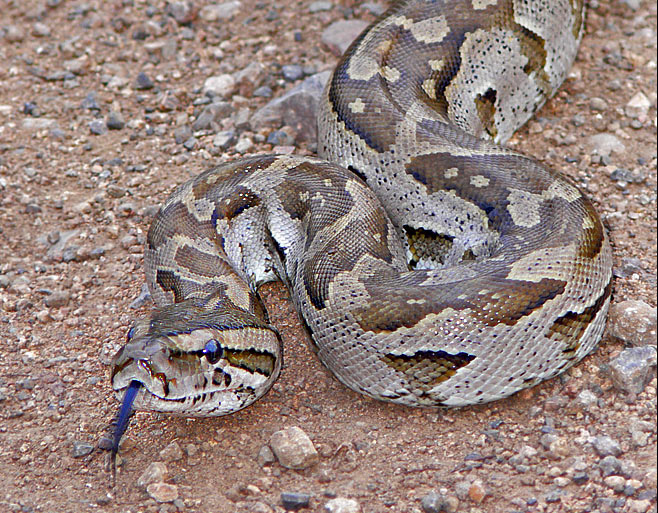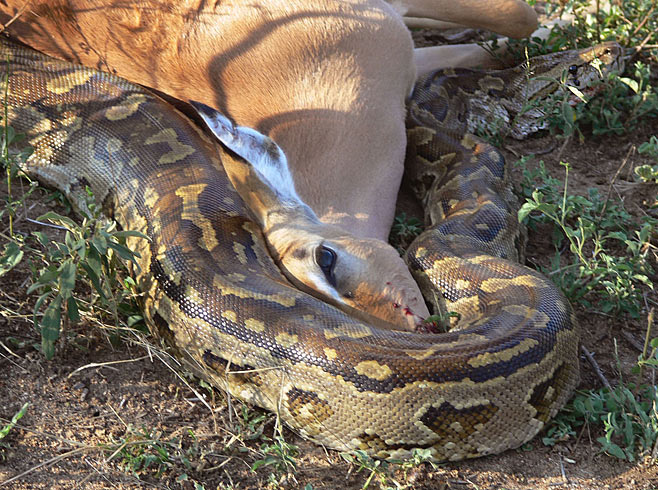|
Python natalensis (South African python, Natal rock python)
Suider-Afrikaanse luislang [Afrikaans]; inHlwathi, uMonya,
imFundamo [Zulu];
iNamba, iFoli, uGqoloma [Xhosa]; inHlathu [Ndebele]; Nhlarhu [Tsonga]; Hlware
[Sotho/ Tswana]; Tharu [Venda]; Shatu [Shona]
Life >
Eukaryotes
>
Opisthokonta >
Metazoa
(animals) > Bilateria > Deuterostomia >
Chordata >
Craniata > Vertebrata (vertebrates) > Gnathostomata (jawed vertebrates) >
Teleostomi (teleost fish) > Osteichthyes (bony fish) > Class:
Sarcopterygii (lobe-finned fish) > Stegocephalia (terrestrial vertebrates) >
Tetrapoda
(four-legged vertebrates) > Reptiliomorpha > Amniota >
Reptilia (reptiles) >
Romeriida > Diapsida > Lepidosauromorpha > Lepidosauria >
Squamata > Serpentes (snakes) >
Family: Boidae > Genus: Python
 |
|
Young South African python about 1.8m long, Kruger
National Park. [photo Lorinda Steenkamp
©] |
 |
|
Python natalensis (South African python, Natal rock python)
with Impala it has killed. [photo Arno Meintjes
©] |
Identification
The South African python can be identified the following, a
dark brown body with dark speckling and grey or brown splotches, an arrow head
marking on its head and its large size (It is the largest snake in southern
Africa). This snake has an average length of 4 meters but has been recorded as
growing up to 6 meters.
Distribution and habitat
Distribution extends from Kenya and Burundi south to
southern Africa. Within southern Africa is is found in southern Mozambique,
Zimbabwe, Botswana, northern Namibia, Swaziland and South Africa (northern
KwaZulu-Natal, Mpumalanga and Limpopo). It is present in a wide variety of
habitats including savanna and lowland forest.
Food
Includes
rodents (e.g.
cane rats),
hares,
monkeys, small
antelope,
birds, fish, crocodiles and monitor lizards; Juveniles feed on
rodents
(e.g. mice) and
birds.
Predators, parasites and disease
Fed on by the following animals
mongooses,
meerkats, crocodiles,
wild dogs,
hyenas,
honey badgers and other
snakes.
Reproduction
Oviparous (egg laying) - generally between 30 and 60 eggs are
laid in a disused
termite mound, This snake is well known for coiling around its
eggs in order to provide protection and enable them to hatch faster.
Longevity
This python species has been known to live for 30 years in
captivity.
Medical importance
Although non-venomous, pythons are dangerous because of
powerful teeth which can cause tissue damage so severe that stitches may be
needed; a large python can kill a person and there are a few records of this
happening.
Links
References
-
Broadley, D.G. 1983. FitzSimons' Snakes of Southern
Africa. Delta Books, Johannesburg.
-
Marais J. 2004. A Complete Guide to Snakes of Southern Africa.
Struik Publishing, Cape Town.
|
